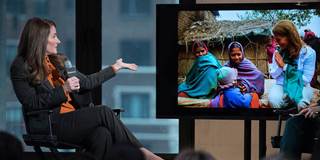The Bill & Melinda Gates Foundation spends more each year on development than most rich governments do. Everyone – from elected officials and bureaucrats to voters and taxpayers – can learn from the world’s largest charitable foundation about effective development spending.
NEW YORK – Everyone – from elected officials and bureaucrats to voters and taxpayers – can learn from the world’s largest charitable foundation about effective development spending. And these lessons are particularly relevant at a time when 56% of Europeans believe their governments should focus solely on domestic issues and let recipient countries deal with problems as best they can (opposition to aid is even higher in France, Poland, Italy, Hungary, and Greece).
The United Kingdom’s largest-circulation Sunday newspaper recently launched a petition calling for an end to ring-fenced aid spending (worth 0.7% of national income). Prior to his election victory, US President Donald Trump railed against “sending foreign aid to countries that hate us,” reflecting a widespread belief that aid needs to be cut. The United States allocates less than 1% of the federal budget to aid, but the average American believes this figure to be thirty-one-times higher.
The Bill & Melinda Gates Foundation spends more each year on development aid than most rich governments do. Unlike elected governments, which face competing priorities, ranging from diplomatic concerns to taxpayer sentiment, the Gates Foundation can focus on what works best. This is nowhere clearer than in Bill and Melinda’s just-released annual newsletter, in which they explain to businessman Warren Buffett how his $30 billion pledge to their foundation – the biggest single gift ever given – is being spent. They zero in on three specific investment areas: vaccination, contraception, and nutrition.

NEW YORK – Everyone – from elected officials and bureaucrats to voters and taxpayers – can learn from the world’s largest charitable foundation about effective development spending. And these lessons are particularly relevant at a time when 56% of Europeans believe their governments should focus solely on domestic issues and let recipient countries deal with problems as best they can (opposition to aid is even higher in France, Poland, Italy, Hungary, and Greece).
The United Kingdom’s largest-circulation Sunday newspaper recently launched a petition calling for an end to ring-fenced aid spending (worth 0.7% of national income). Prior to his election victory, US President Donald Trump railed against “sending foreign aid to countries that hate us,” reflecting a widespread belief that aid needs to be cut. The United States allocates less than 1% of the federal budget to aid, but the average American believes this figure to be thirty-one-times higher.
The Bill & Melinda Gates Foundation spends more each year on development aid than most rich governments do. Unlike elected governments, which face competing priorities, ranging from diplomatic concerns to taxpayer sentiment, the Gates Foundation can focus on what works best. This is nowhere clearer than in Bill and Melinda’s just-released annual newsletter, in which they explain to businessman Warren Buffett how his $30 billion pledge to their foundation – the biggest single gift ever given – is being spent. They zero in on three specific investment areas: vaccination, contraception, and nutrition.